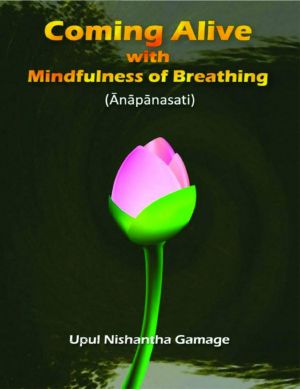Coming Alive with Mindfulness of Breathing

- Authors
- Gamage, Upul Nishantha
- Publisher
- Upul Nishantha Gamage
- Tags
- happiness , mindfullness , buddhist , mind , peace and joy , mindful , buddhist books
- ISBN
- 9781370681914
- Date
- 2017-06-06T00:00:00+00:00
- Size
- 0.26 MB
- Lang
- en
This book is based upon public talks given by Upul Nishantha Gamage, on the Buddhist teaching as recorded in the discourse of Girimānanda Sutta.
The Buddhist teaching, with its ten insightful ‘perceptions,’ prepares the ground for the seeds of awareness to be planted, cultivating the right attitude and intention before we start our work. The 10th Perception is Ānāpāna Sati, and here the Ānāpāna Sati Sutta and the Satipaṭṭhāna Sutta come in to guide us in detail through all the steps of meditation up to spiritual awakening. As to when and how that day will dawn, we don’t know. But it is certain that every good seed well cared for will in time flourish and grow and one day bear fruit. Every step of the way is an opportunity for us to deepen in understanding and joy – awakening from a beginning-less slumber to the beauty of life and to the vastness of our potential.
" One day the Lord Buddha asked monk Aritta, “Do you practice Mindfulness of Breathing meditation?” He replied, “Yes I do practice Composure of Mindfulness of Breathing.”
“How?”
“I do not tour in the past with lust, do not dream of the future with lust, do not run with lust, do not wander in the past or the future in lust or in aversion, thereby I do not get attached or distressed. Being in the present, I breathe in and out with awareness". Here the Lord Buddha appreciates this and declares that the Composure of Mindfulness of Breathing can be practiced and developed that way too.
Living in the present moment is being discussed in different aspects, Dear Dhamma Friends - the breath happens totally in the present moment. In-breath fully happens in the present moment; out-breath fully happens in the present moment; this moment, here and now. There is no division whatsoever - poor-rich, learned-illiterate, brainy-foolish, ethnic, religious, national, political, good-bad. No division in any of these categories, which are usually found in society. When it comes to breath, everybody without any distinction has breath which is totally equal. There is no room here for either a ballooned ego, or an inferiority complex, condemning yourself as a person who can’t do anything and who can’t achieve anything. Since this activity develops concentration by being aware of the in-breath and out-breath, it is called the Composure of the Mindfulness of Breathing.
It can be practiced by anybody
Most meditation techniques, are not easy to practice. It is difficult to find a universal technique which could be practiced by everybody, because of personal anticipations and opinions. Just imagine a person who admires beauty, who leads a romantic life, cannot meditate on impurities; cannot meditate by looking at decayed things and decomposed flesh; such minds will never be concentrated. On the other hand, someone who is always distressed, who is in anger, cannot meditate on loving-kindness. When you ask such a person to develop Metta (unlimited friendliness), they only develop more aversion. A person who always thinks logically and always tries to argue and also thinks scientifically cannot practice contemplating on Buddha’s qualities where you develop a belief, faith, and devotion. A logical mind cannot practice these recollection meditation techniques. They have to come from the heart. Faith is a quality of the heart. Faith is in the heart, not in the head or the brain. A person who gets scared by anything and looks suspiciously at everything cannot practice contemplation on death because it can increase paranoia and instability. Therefore, Dear Dhamma Friends, most of the meditation techniques have to be evaluated and selected according to the person’s mind and their thinking patterns to establish the best fit.
But, when you consider Mindfulness of Breathing, it can be practiced by anybody who can feel that he is breathing. Therefore, on the whole, Mindfulness of Breathing meditation can be practiced by anybody, a small child or even an old person.... ''